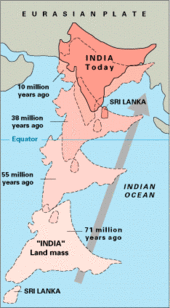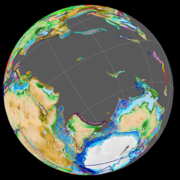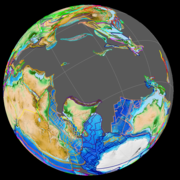ਭਾਰਤੀ ਉਪਮਹਾਂਦੀਪ
 | |
| ਖੇਤਰਫਲ | 44 ਲੱਖ ਕਿਮੀ2 (17 ਲੱਖ ਮੀਲ2) |
|---|---|
| ਅਬਾਦੀ | ~180 ਕਰੋੜ |
| ਦੇਸ਼ | |
ਭਾਰਤੀ ਉਪਮਹਾਂਦੀਪ ਏਸ਼ੀਆ ਦੇ ਦੱਖਣ ਵਿੱਚ, ਮੁੱਖ ਤੌਰ 'ਤੇ ਭਾਰਤੀ ਤਖਤੇ ਤੇ ਸਥਿਤ ਹਿੰਦ ਮਹਾਸਾਗਰ ਵੱਲ ਵਧੇ ਹੋਏ ਖੇਤਰ ਨੂੰ ਕਿਹਾ ਜਾਂਦਾ ਹੈ। ਇਸ ਵਿੱਚ ਭਾਰਤ, ਪਾਕਿਸਤਾਨ, ਬੰਗਲਾਦੇਸ਼ ਅਤੇ ਸ੍ਰੀਲੰਕਾ ਸ਼ਾਮਿਲ ਹਨ।[1] ਆਜ਼ਾਦੀ ਤੋਂ ਪਹਿਲਾਂ ਇਹ ਤਿੰਨੋਂ ਦੇਸ਼ ਇਤਹਾਸਕ ਤੌਰ 'ਤੇ ਸੰਯੁਕਤ ਸਨ ਅਤੇ ਬਰਤਾਨਵੀ ਭਾਰਤ ਦੇ ਹਿੱਸੇ ਸਨ। ਇਸ ਵਿੱਚ ਨੇਪਾਲ, ਭੂਟਾਨ ਅਤੇ ਟਾਪੂ ਦੇਸ਼ ਸ੍ਰੀ ਲੰਕਾ ਵੀ ਅਕਸਰ ਗਿਣ ਲਏ ਜਾਂਦੇ ਹਨ।[2][3] ਅੱਗੇ ਅਫਗਾਨਿਸਤਾਨ ਅਤੇ ਮਾਲਦੀਵ ਟਾਪੂ ਸਮੂਹ ਵੀ ਸ਼ਾਮਲ ਸਮਝੇ ਜਾ ਸਕਦੇ ਹਨ।[4][5]ਇਸ ਖੇਤਰ ਨੂੰ ਉਪ-ਮਹਾਦੀਪ ਇਸ ਲਈ ਕਿਹਾ ਜਾਂਦਾ ਹੈ ਕਿ ਇਹ ਭੂਗੋਲਿਕ ਗਿਆਨ ਭੂ-ਵਿਗਿਆਨ ਦੇ ਅਨੁਸਾਰ ਇਸ ਮਹਾਂਦੀਪ ਦੇ ਹੋਰ ਖੇਤਰਾਂ ਤੋਂ ਵੱਖ ਹੈ। ਇਸ ਦੇ ਅੰਦਰ, ਲੋਕਾਂ, ਭਾਸ਼ਾਵਾਂ ਅਤੇ ਧਰਮਾਂ ਦੀ ਵੱਡੀ ਵਿਵਿਧਤਾ ਮਿਲਦੀ ਹੈ।
ਨਾਮਕਰਣ
[ਸੋਧੋ]ਆਕਸਫੋਰਡ ਡਿਕਸ਼ਨਰੀ ਦੇ ਅਨੁਸਾਰ ਉਪਮਹਾਂਦੀਪ ਸ਼ਬਦ ਦਾ ਅਰਥ ਹੈ "ਇੱਕ ਮਹਾਂਦੀਪ ਦੀ ਹਿੱਸਾ ਜਿਸਦੀ ਇੱਕ ਵੱਖਰੀ ਭੂਗੋਲਿਕ, ਰਾਜਨੀਤਿਕ, ਜਾਂ ਸੱਭਿਆਚਾਰਕ ਪਛਾਣ ਹੋਵੇ" ਵੀਹਵੀਂ ਸਦੀ ਦੇ ਸ਼ੁਰੂ ਵਿੱਚ ਲਗਭਗ ਸਾਰਾ ਹੀ ਹਿੱਸਾ ਬਰਤਾਨਵੀ ਸਾਮਰਾਜ ਦੇ ਅਧੀਨ ਸੀ ਅਤੇ ਉਸ ਵੇਲੇ ਅਕਸਰ ਹੀ ਬ੍ਰਿਟਿਸ਼ ਭਾਰਤ ਅਤੇ ਰਾਜੇ ਦੀਆਂ ਰਿਆਸਤਾਂ ਨੂੰ ਸਮੁੱਚੇ ਤੌਰ ਤੇ ਭਾਰਤੀ ਉਪ ਮਹਾਂਦੀਪ ਆਖਿਆ ਜਾਂਦਾ ਸੀ।[6][7]
ਹੋਂਦ ਦਾ ਵਿਗਿਆਨਕ ਪੱਖ
[ਸੋਧੋ]
ਭਾਰਤੀ ਉਪ-ਮਹਾਂਦੀਪ ਪਹਿਲਾਂ ਗੋਂਡਵਾਨਾ ਦਾ ਹਿੱਸਾ ਸੀ, ਇੱਕ ਵੱਡਾ ਮਹਾਂਦੀਪ, ਜੋ ਅੰਤਮ ਪਰਾਗਜੀਵੀ ਅਤੇ ਸ਼ੁਰੂਆਤੀ ਪਰਾਜੀਵੀ ਯੁੱਗ ਦੌਰਾਨ ਬਣਿਆ ਸੀ।[8] ਉਹ ਖੇਤਰ ਜਿੱਥੇ ਯੂਰੇਸ਼ੀਅਨ ਅਤੇ ਭਾਰਤੀ ਉਪ ਮਹਾਂਦੀਪ ਦੀਆਂ ਪਲੇਟਾਂ ਮਿਲਦੀਆਂ ਹਨ, ਭੂ-ਵਿਗਿਆਨਕ ਤੌਰ 'ਤੇ ਸਰਗਰਮ ਰਹਿੰਦਾ ਹੈ, ਅਤੇ ਅਕਸਰ ਹੀ ਓਥੇ ਵੱਡੇ ਭੁਚਾਲਾਂ ਦਾ ਖ਼ਤਰਾ ਰਹਿੰਦਾ ਹੈ।[9] ਜਿਸ ਕਾਰਨ ਗੋਂਡਵਾਨਾ ਮੀਸੋਜੋਇਕ ਯੁੱਗ ਦੌਰਾਨ ਟੁੱਟਣਾ ਸ਼ੁਰੂ ਹੋਇਆ ਅਤੇ ਇਹ ਅੰਟਾਰਕਟਿਕਾ ਤੋਂ130-120 ਮਿਲੀਅਨ ਸਾਲ ਪਹਿਲਾਂ ਅਤੇ ਮੈਡਾਗਾਸਕਰ ਤੋਂ ਲਗਭਗ 90 ਮਿਲੀਅਨ ਸਾਲ ਪਹਿਲਾਂ ਵੱਖ ਹੋਇਆ।[10][11] 55 ਮਿਲੀਅਨ ਵਰ੍ਹੇ ਪਹਿਲਾਂ, ਮੀਸੋਜੋਇਕ ਯੁੱਗ ਦੇ ਅਖੀਰ ਵਿੱਚ ਟਾਪੂ ਰੂਪੀ ਭਾਰਤ ਯੂਰੇਸ਼ੀਅਨ ਪਲੇਟ ਨਾਲ ਟਕਰਾਇਆ ਜਿਸ ਨਾਲ ਭਾਰਤੀ ਉਪ ਮਹਾਂਦੀਪ ਹੋਂਦ ਵਿੱਚ ਆਇਆ।[12]
ਭੂਗੋਲਿਕ ਸਥਿਤੀ
[ਸੋਧੋ]ਮਾਨਵ-ਵਿਗਿਆਨੀ ਜੌਹਨ ਆਰ. ਲੂਕਾਕਸ ਦੇ ਅਨੁਸਾਰ, "ਭਾਰਤੀ ਉਪਮਹਾਂਦੀਪ ਦੱਖਣੀ ਏਸ਼ੀਆ ਦੇ ਵੱਡੇ ਭੂਮੀ ਖੇਤਰ 'ਤੇ ਕਾਬਜ਼ ਹੈ।"[13]ਭੂਗੋਲ ਵਿਗਿਆਨੀ ਡਡਲੇ ਸਟੈਂਪ ਦੇ ਅਨੁਸਾਰ, " ਦੁਨੀਆ ਦੀ ਕੋਈ ਵੀ ਮੁੱਖ ਭੂਮੀ ਭਾਰਤੀ ਉਪ ਮਹਾਂਦੀਪ ਦੀ ਭੂਗੋਲਿਕ ਸਥਿਤੀ ਨਾਲੋਂ ਵਧੀਆ ਨਹੀਂ ਹੈ।"[14]
ਹਿਮਾਲਿਆ (ਪੂਰਬ ਵਿੱਚ ਬ੍ਰਹਮਪੁੱਤਰ ਨਦੀ ਤੋਂ ਪੱਛਮ ਵਿੱਚ ਸਿੰਧ ਨਦੀ ਤੱਕ), ਕਾਰਾਕੋਰਮ (ਪੂਰਬ ਵਿੱਚ ਸਿੰਧ ਨਦੀ ਤੋਂ ਪੱਛਮ ਵਿੱਚ ਯਰਕੰਦ ਨਦੀ ਤੱਕ) ਅਤੇ ਹਿੰਦੂ ਕੁਸ਼ ਪਹਾੜ (ਯਾਰਕੰਦ ਨਦੀ ਤੋਂ ਪੱਛਮ ਵੱਲ) ਇਸਦੀ ਉੱਤਰੀ ਸੀਮਾ ਬਣਾਉਂਦੇ ਹਨ।[15] ਪੱਛਮ ਵਿੱਚ ਇਹ ਹਿੰਦੂ ਕੁਸ਼, ਸਪਿਨ ਘਰ (ਸਫੇਦ ਕੋਹ), ਸੁਲੇਮਾਨ ਪਰਬਤ, ਕਿਰਥਾਰ ਪਰਬਤ, ਬਰਹੂਈ ਪਰਬਤ ਲੜੀ ਅਤੇ ਪਾਬ ਲੜੀ ਦੇ ਕੁਝ ਹਿੱਸਿਆਂ ਨਾਲ ਘਿਰਿਆ ਹੋਇਆ ਹੈ।[16] ਸਰਹੱਦ ਦੇ ਨਾਲ ਪੱਛਮੀ ਫੋਲਡ ਬੈਲਟ ( ਸੁਲੇਮਾਨ ਰੇਂਜ ਅਤੇ ਚਮਨ ਫਾਲਟ ਦੇ ਵਿਚਕਾਰ) ਭਾਰਤੀ ਪਲੇਟ ਦੀ ਪੱਛਮੀ ਸੀਮਾ ਹੈ,ਜਿੱਥੇ, ਪੂਰਬੀ ਹਿੰਦੂ ਕੁਸ਼ ਦੇ ਨਾਲ, ਅਫਗਾਨਿਸਤਾਨ-ਪਾਕਿਸਤਾਨ ਸਰਹੱਦ ਸਥਿਤ ਹੈ।[16] ਪੂਰਬ ਵਿੱਚ, ਇਹ ਪਟਕਾਈ, ਨਾਗਾ, ਲੁਸ਼ਾਈ ਅਤੇ ਚਿਨ ਪਹਾੜੀਆਂ ਨਾਲ ਘਿਰਿਆ ਹੋਇਆ ਹੈ। ਹਿੰਦ ਮਹਾਸਾਗਰ, ਬੰਗਾਲ ਦੀ ਖਾੜੀ ਅਤੇ ਅਰਬ ਸਾਗਰ ਦੱਖਣ, ਦੱਖਣ-ਪੂਰਬ ਅਤੇ ਦੱਖਣ-ਪੱਛਮ ਵਿੱਚ ਭਾਰਤੀ ਉਪ ਮਹਾਂਦੀਪ ਦੀ ਸੀਮਾ ਬਣਾਉਂਦੇ ਹਨ।[16]
ਹਵਾਲੇ
[ਸੋਧੋ]- ↑ "Indian subcontinent". New Oxford Dictionary of English (ISBN 0-19-860441-6) New York: Oxford University Press, 2001; p. 929.
- ↑ "Indian subcontinent" > Geology and Geography. The Columbia Electronic Encyclopedia, 6th ed. Columbia University Press, 2003: "region, S central Asia, comprising the countries of Pakistan, India and Bangladesh and the Himalayan states of Nepal and Bhutan. Sri Lanka, an island off the southeastern tip of the Indian peninsula, is often considered a part of the subcontinent."
- ↑ Singh, Yash Pal (2008). Map Workbook. V K Publications. p. 4. ISBN 978-8189611835.
- ↑ Stephen Adolphe Wurm, Peter Mühlhäusler & Darrell T. Tryon, Atlas of languages of intercultural communication in the Pacific, Asia, and the Americas, pages 787, International Council for Philosophy and Humanistic Studies, Published by Walter de Gruyter, 1996, ISBN 3-11-013417-9.
- ↑ Haggett, Peter (2001). Encyclopedia of World Geography (Vol. 1). Marshall Cavendish. p. 2710. ISBN 0-7614-7289-4.
- ↑ Milton Walter Meyer, South Asia: A Short History of the Subcontinent, pages 1, Adams Littlefield, 1976, ISBN 0-8226-0034-X.
- ↑ "Indian subcontinent" is used by Henry D. Baker, British India With Notes On Ceylon Afghanistan And Tibet (1915), p. 401.
- ↑ Robert Wynn Jones (2011). Applications of Palaeontology: Techniques and Case Studies. Cambridge University Press. pp. 267–271. ISBN 978-1-139-49920-0.
- ↑ Bethany D. Rinard Hinga (2015). Ring of Fire: An Encyclopedia of the Pacific Rim's Earthquakes, Tsunamis, and Volcanoes. ABC-CLIO. pp. 89–90. ISBN 978-1-61069-297-7.
- ↑ Gaina, Carmen; Müller, R. Dietmar; Brown, Belinda; Ishihara, Takemi; Ivanov, Sergey (July 2007). "Breakup and early seafloor spreading between India and Antarctica". Geophysical Journal International. 170 (1): 151–169. Bibcode:2007GeoJI.170..151G. doi:10.1111/j.1365-246X.2007.03450.x.
- ↑ Alexander E. Gates; David Ritchie (2006). Encyclopedia of Earthquakes and Volcanoes. Infobase. pp. 116–118. ISBN 978-0-8160-7270-5.
- ↑ Robert Wynn Jones (2011). Applications of Palaeontology: Techniques and Case Studies. Cambridge University Press. pp. 267–271. ISBN 978-1-139-49920-0.
- ↑ John R. Lukacs, The People of South Asia: the biological anthropology of India, Pakistan, and Nepal, page 59, Plenum Press, 1984, ISBN 9780306414077.
- ↑ L. Dudley Stamp (1957). India, Pakistan, Ceylon and Burma. London: Methuen. p. 185. OCLC 213547929.
- ↑ Samiul Hasan, The Muslim World in the 21st Century: Space, Power, and Human Development, page 84, Springer Science & Business Media, 2012, ISBN 9789400726321.
- ↑ 16.0 16.1 16.2 Bratindra Nath Mukherjee, Nationhood and Statehood in India: A historical survey, page 4, Regency Publications, 2001, ISBN 9788187498261.




